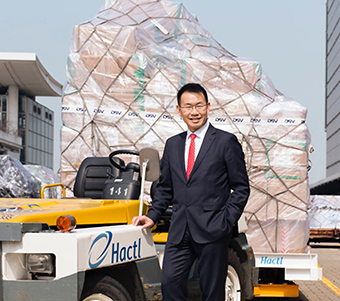-
News Feed
-
Thursday, 20 June 2019
OPERATING since 1976, Hong Kong Air Cargo Terminals Limited (Hactl) supports the import, export and trans-shipment of air cargo in Hong Kong, contributing to the growth of the Chinese island’s economy.
 SuperTerminal 1 is the single largest multi-level air cargo terminal in the world, boasting 3,500 container storage system positions, 10,000 box storage system positions and a range of specialised cargo handling facilities to cater for all cargo types including temperature-controlled products, valuable goods and livestock. The facility is capable of handling up to 3.5 million tonnes of air cargo every year.
SuperTerminal 1 is the single largest multi-level air cargo terminal in the world, boasting 3,500 container storage system positions, 10,000 box storage system positions and a range of specialised cargo handling facilities to cater for all cargo types including temperature-controlled products, valuable goods and livestock. The facility is capable of handling up to 3.5 million tonnes of air cargo every year.
Key to SuperTerminal 1’s performance is COSAC-Plus, a new generation air cargo management system that enables the most efficient cargo tracking, information sharing and facilitates e-freight.
The system is designed for all airlines, freight forwarders and related government departments to monitor and manage air cargo handled by Hactl. Every day, the system handles more than 3,500 users and over 1,000,000 data transactions.
Asia-Pacific airlines saw demand for air freight contract by 7.4 per cent in April 2019, compared to the same period in 2018. A trade war between the US and China currently impacts freight movements, resulting in falling demand in the region, where international volumes are down 8.1 per cent compared to a year ago.
Wilson Kwong, chief executive Hactl (pictured above) spoke to Aircargo Asia-Pacific on the effects of the current impasse in trade negotiations between the two super powers and his plans for returning Hactl to growth.
Hong Kong International Airport (HKIA) is focusing on cross-boundary e-commerce, high-value cargo and enhancing regional cargo services. How does this fit with Hactl’s own plans?
HKIA’s future direction is fully aligned with Hactl’s. For some years, our value-added logistics subsidiary Hacis has supported the e-commerce sector with dedicated services enhanced by its specialised IT system, plus an inland cargo depot in China (one of its nine-strong network) located in Nansha, southern Guangzhou within a dedicated e-commerce zone and, most recently, by working with postal authorities to provide a cost-effective export gateway for mail containing electronic and other e-commerce packages.
 The decision by Cianiao to open a premium logistics centre in Hong Kong is a huge vote of confidence in the airport and its administration, and Hactl hopes to participate in this new venture as a service partner.
The decision by Cianiao to open a premium logistics centre in Hong Kong is a huge vote of confidence in the airport and its administration, and Hactl hopes to participate in this new venture as a service partner.
Meanwhile, HKIA’s recent initiative to create the world’s first IATA CEIV Fresh hub is also something we strongly support.
Hactl was the first WHO GDP-certified handler in Hong Kong, and now is the first to certify under CEIV Pharma (for which we received our certification at the World Cargo Symposium in Singapore).
CEIV Fresh is based totally on airline requirements and so will quickly gain critical mass in the industry. This encourages exactly the kind of uniformity in standards and processes which the industry needs in order to safeguard existing perishables and pharma traffic (the two being closely related due to similarities in their requirements) and to attract new business. The modern consumer expects year-round availability of all commodities and this presents a huge opportunity for air cargo. But we all have to meet the same high standards so that goods arrive in peak condition.
Hong Kong is a natural location for a major regional Asian hub. It’s centrally located, has unparalleled air connections, offers choice of carrier and plentiful maindeck capacity, enjoys a modern Customs regime and is bi-lingual. With the opening of the three runway system, we will also have unrestricted capacity for growth.
Chinese air hubs face pressure from challenges brought by the rise of cross-border e-commerce. How has this impacted Hactl?
As mentioned earlier, Hacis is working closely with postal authorities to provide a fast and efficient export route for e-commerce cargo. It currently handles some 3,000 mail bags daily. New contracts under discussion will add to this traffic. Again, the spread of destinations served, the choice of carrier, the frequencies, the maindeck capacity and the trade-supportive Customs regime all favour Hong Kong and Hactl. I believe we will increasingly be seen as China’s e-commerce gateway – just as we have been seen as China’s global cargo gateway over several decades.
 Asia-Pacific airlines saw demand for air freight contract by 7.4 per cent in April 2019 compared to the same period in 2018. How is the current China-USA trade spat affecting Hactl’s growth targets?
Asia-Pacific airlines saw demand for air freight contract by 7.4 per cent in April 2019 compared to the same period in 2018. How is the current China-USA trade spat affecting Hactl’s growth targets?
The current friction over trade between China and the USA has certainly had an impact at Hactl, but it is far less than we initially feared – around five per cent down year to date. This is actually better than the local market as a whole, and we attribute this result to our proactive measures to increase traffic in the pharma, fresh and e-commerce sectors, which have cushioned us. Longer term, we believe the disputes will be resolved, and that organic growth alone will mitigate any lasting impacts.
Do you plan initiatives to counter a general trade downturn globally?
Global trade never rises in a long, straight line: It’s a series of peaks and troughs which materialise in air cargo traffic globally. We take the long term view that global trade will always increase and that, with our 100-strong airline portfolio’s global coverage, we will enjoy growth whenever and wherever it occurs.
But, rather than taking for granted natural organic growth, we continue to partner with our airline customers to strengthen and broaden their service offerings.
And, behind the scenes, we continue to invest and innovate in order to create the highest possible service standards. We are deeply invested in our customers: We can only be successful if they are. The scope and quality of Hactl services becomes a strong sales tool for them. This is our constant motivation.
AI and technology have revolutionised the way air freight is being handled today. What progress has Hactl made with technology?
Hactl has always believed in the need to employ the latest and best technology. We have a proud 43-year history of innovation - including designing, building and constantly improving our own IT systems (COSAC-Plus is the third iteration of  our self-developed community cargo management system) using in-house resources.
our self-developed community cargo management system) using in-house resources.
We already employ AI to deal with repetitive, labour-intensive processing such as charter job management and invoicing, and to add security to our mission-critical IT systems by constant monitoring for cyber threats. There are additional potential applications for AI which we are currently evaluating.
Our engagement with innovation is driven by our Performance Enhancement team, whose sole task is to uncover areas for improvement in our processes, working methods and infrastructure. Their biggest success so far has been the switch to mobile computing throughout our giant facility, which has revolutionised our business. More recently, they devised the Smart Cargo Locating system which combines RFID and GPS technology to streamline the task of racking and retrieving outsize loose cargo – which has a direct positive impact on performance during ULD build-up.
We continue to invest in innovation. Hactl is ahead of the game, and we want to stay that way!
Perishable goods is a growing market for air cargo. Ensuring short-shelf life products reach the customer unspoiled with minimal waste and loss is essential. How do Hactl’s facilities stack up?
Through initial and ongoing investment, Hactl’s facilities and processes have always been the best available. This begins with a large, purpose-built, multi-zone temperature controlled facility that includes thermal dollies for temperature conservation in transit on the apron. What has changed in recent times is our certification, first under GDP and subsequently under CEIV Pharma and CEIV Fresh.
This required relatively little work or adaptation, because of our already-advanced status - but it meant we now comply with a standard recognised and accepted by all airlines.
As the rest of the industry moves to adopt the same standard, it will achieve the end-to-end uniformity, conformity and consistency that all pharma and fresh supply chains demand. This will consolidate our industry’s position and nurture further growth in our markets that will benefit all players.
Hactl has a strong safety record in place. What initiatives are in place to promote this focus?
Hactl has worked hard for many years to create a safe and comfortable working environment for its workforce: We believe that is the staff’s right, and our duty. Awareness and practising safe working procedures is paramount, and is an inherent part of our intensive in-house training program. To reinforce this, we hold two events each year designed to drive home the need for constant vigilance: Our International Forklift Truck Driving and Pallet Building competition (to which we also invite our customers as participants), and our annual Safety Week – which brings together an intensive program of events, presentations and activities that are designed to raise safety awareness among our 2400 staff. Yet again, it’s a significant investment – but one we support wholeheartedly. Our staff are our most valuable asset and we do everything possible to protect them.
 Any expansion plans to tackle increased competition?
Any expansion plans to tackle increased competition?
Competition in Hong Kong is strong, but it’s also a motivator to be better – and it holds no fears for Hactl. Last year, Hactl once again renewed its handling concession for a further 10 years because we are here to stay.
Yes, we have many plans to expand our business and our resources, but we are not at liberty to divulge these at present.
Is cybersecurity a problem for facilities like Hactl?
Hactl is a mission-critical business for Hong Kong. If it ceased to function, even for a few hours, it would bring the airport to a standstill. That’s why we take even the remotest risk of cyber attacks extremely seriously. All our systems have been re-written using the latest IT architecture and run on state-of-the-art equipment, which provides greatly-enhanced security. But we also employ AI to provide an early-warning system for any suspicious activity. That, with parallel redundant IT infrastructure, robust procedures and the best possible housekeeping ensure that Hactl and its customers remain secure from any attack.
Does Hactl see any threat to future growth by deliveries from drones operating from off-airport sites?
Drone technology is fascinating, and there is a place for it in the logistics industry. But its current nature and limitations favour small payloads over relatively short distances – so it is unlikely to make visible inroads into the mainstream global air cargo industry, at least for the foreseeable future.
 Over the next 20 years, forecasts indicate passenger numbers will grow to 19.8 million – including 3.3 million international travellers – while air freight will almost triple from 58,500 tonnes to 146,000 tonnes.
Over the next 20 years, forecasts indicate passenger numbers will grow to 19.8 million – including 3.3 million international travellers – while air freight will almost triple from 58,500 tonnes to 146,000 tonnes. 






 Under the umbrella of efficiency, Gittens said: “While the new governance structure for the Worldwide Slot Guidelines, and the new aerodrome standards are milestones in the right direction, airport stakeholders need to increase their harmonised efforts when it comes to seamless connectivity and NEXTT can help.”
Under the umbrella of efficiency, Gittens said: “While the new governance structure for the Worldwide Slot Guidelines, and the new aerodrome standards are milestones in the right direction, airport stakeholders need to increase their harmonised efforts when it comes to seamless connectivity and NEXTT can help.” However, there is still no clarity when the legislation implementing PAFTA will be reintroduced and passed after it lapsed with the dissolution of the 45th Federal parliament on 11 April 2019.
However, there is still no clarity when the legislation implementing PAFTA will be reintroduced and passed after it lapsed with the dissolution of the 45th Federal parliament on 11 April 2019.  If readers have an interest in the issue I would recommend making a submission by the closing date, otherwise a lack of submissions could lead our government to surrender a GI as part of the negotiation process.
If readers have an interest in the issue I would recommend making a submission by the closing date, otherwise a lack of submissions could lead our government to surrender a GI as part of the negotiation process. “Increasing economic growth would be a boon to an air cargo industry suffering this year’s falling demand, load factors, and yields,” says Alan Hedge, principal of
“Increasing economic growth would be a boon to an air cargo industry suffering this year’s falling demand, load factors, and yields,” says Alan Hedge, principal of “The US may be entering the home stretch of its longest war, as peace talks with the Taliban in Afghanistan show movement,” said Hedge. “And a possible silver lining? Perhaps the UK’s looming crash out of the European Union will be a teachable moment to other countries on the fence about remaining in the bloc.”
“The US may be entering the home stretch of its longest war, as peace talks with the Taliban in Afghanistan show movement,” said Hedge. “And a possible silver lining? Perhaps the UK’s looming crash out of the European Union will be a teachable moment to other countries on the fence about remaining in the bloc.” The plan is mandated by mid-1990s legislation as specified in the Airports Act 1996.
The plan is mandated by mid-1990s legislation as specified in the Airports Act 1996. SuperTerminal 1 is the single largest multi-level air cargo terminal in the world, boasting 3,500 container storage system positions, 10,000 box storage system positions and a
SuperTerminal 1 is the single largest multi-level air cargo terminal in the world, boasting 3,500 container storage system positions, 10,000 box storage system positions and a The decision by Cianiao to open a premium logistics centre in Hong Kong is a huge vote of confidence in the airport and its administration, and Hactl hopes to participate in this new venture as a service partner.
The decision by Cianiao to open a premium logistics centre in Hong Kong is a huge vote of confidence in the airport and its administration, and Hactl hopes to participate in this new venture as a service partner. Asia-Pacific airlines saw demand for air freight contract by 7.4 per cent in April 2019 compared to the same period in 2018. How is the current China-USA trade spat affecting Hactl’s growth targets?
Asia-Pacific airlines saw demand for air freight contract by 7.4 per cent in April 2019 compared to the same period in 2018. How is the current China-USA trade spat affecting Hactl’s growth targets? our self-developed community cargo management system) using in-house resources.
our self-developed community cargo management system) using in-house resources.  Any expansion plans to tackle increased
Any expansion plans to tackle increased Reform would require perseverance and leadership, he said, not just from the largest trading countries but from all WTO members.
Reform would require perseverance and leadership, he said, not just from the largest trading countries but from all WTO members. The ongoing political and trade battle between the US and China (and between the US and Mexico and Canada) fills the front pages of newspapers and stories on television thanks to the significant increases in tariffs by the US and threats to escalate those tariffs and other protective measures. China has threatened to retaliate in similar terms. The inability to complete a multilateral trade deal at the WTO together with the inability to resolve the disagreements between the US and the rest of the world on the appellate division of the WTO or the shape of any rules - based platform to resolve international trade disputes have left massive uncertainty for future plans.
The ongoing political and trade battle between the US and China (and between the US and Mexico and Canada) fills the front pages of newspapers and stories on television thanks to the significant increases in tariffs by the US and threats to escalate those tariffs and other protective measures. China has threatened to retaliate in similar terms. The inability to complete a multilateral trade deal at the WTO together with the inability to resolve the disagreements between the US and the rest of the world on the appellate division of the WTO or the shape of any rules - based platform to resolve international trade disputes have left massive uncertainty for future plans.  been addressed by the Productivity Commission with the publication of its Trade and Assistance Review 2017 - 18 (Review) the most recent of its annual reviews including a chapter entitled ‘The future of the world trading system’ as its ‘Theme Chapter’ to the Review.
been addressed by the Productivity Commission with the publication of its Trade and Assistance Review 2017 - 18 (Review) the most recent of its annual reviews including a chapter entitled ‘The future of the world trading system’ as its ‘Theme Chapter’ to the Review.


